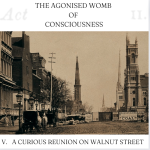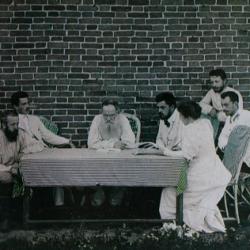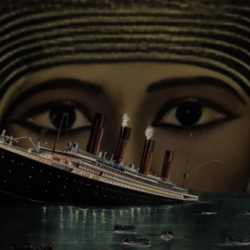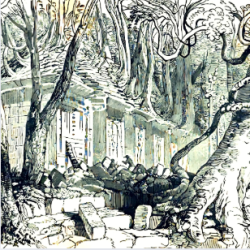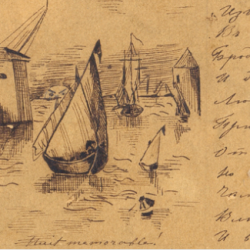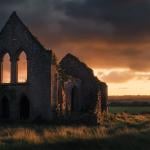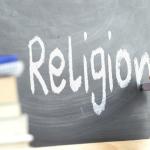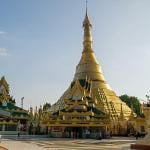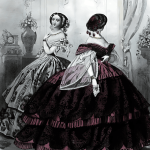GLORIFIED IN THE LAND OF BABYLON
ACT II.
VI.
⸻
The marriage of Verochka and Charley was solemnized on October 12, 1888, at the Register Officer in Kensington. Olcott, Blavatsky, and Charley’s mother, Georgiana Barbara Hay were the witnesses.[1] Being a descendant of the Plantagenets, Georgiana, like Blavatsky, was of minor nobility.[2] Verochka joined the Theosophical Society on the same day the civil marriage was solemnized.[3]

Marriage Registration. [4]
Though they were technically married, the real wedding was to be officiated by Father Evgeny Smirnov on October 14, 1888, at the Church of the Russian Embassy, 32 Welbeck Street, Cavendish Square.[5] In accordance with tradition, Charley and Verochka resided in different houses until their union was solemnized by the Church. Verochka stayed at 17 Lansdowne, while Charley stayed in the home of Richard Harte at 78 Clarendon (just behind 17 Lansdowne.)[6]
On the day of the wedding, Charley, prepared for the wedding ceremony in Harte’s home in the company of Yeats and his siblings, Lewis, Georgie, and Ada. Lewis, having also passed his Civil Service Exam, was appointed by the Secretary of State for Ceylon Civil Service.[7] The brothers were also both Theosophists, and it was they who brought Theosophy back to Ireland. (Georgie and Ada, though both interested in the movement, had not officially enrolled as members.) The Johnston siblings quickly integrated their new theories into their life, such as the dietary praxis of vegetarianism, which was difficult to accommodate in Ireland. (Their friends secretly wished they would abandon the diet.)[8]
“Words are always getting conventionalized to some secondary meaning,” said Yeats. “It is one of the works poetry to take the truants in custody and bring them back to their right senses. Poets are the policemen of language—they are always arresting those old reprobate words.”[9]
Yeats recently completed his epic poem, “The Wanderings of Oisin,” and some critics had taken umbrage with his use of the words “tincture” and “cincture.” Georgie consoled Yeats by affirming the important role he played in the protection of language.
“Witness the rapid spread of a new slang term, Willie,” said Georgie. “The ready adoption of such new words by people who have no reason for using one word in preference to another—people who have ‘caught on to’ an idea, instead of understanding it, whose use of scientific terms is varied by such expressions as ‘daisy,’ ‘tip top,’ ‘blooming,’ or ‘a frost.’ Language is to this class of minds valueless—any words in daily use they appear to think good enough for expressing reflected ideas, filling up space, or killing time. These useless terms and foolish ideas ought to be treated as are weeds, pulled out and left to dry up and perish utterly. But often we take up idly a foolish idea and play with it, adding a touch of color here, there a few fragments of detail—then, tired of it, we let it float away strengthened, to fasten itself to the mind of some other human atom, where it will, perhaps, take root and flourish, producing much bitter and unpalatable fruit. In the Bibles of men, we find constant reference to the fact that thoughts, with words, their expression, are very powerful, and that for them in the same measure as for action man is responsible. Not alone for evil thoughts, but for idle thoughts. It is not enough to pull up the thistles and ragworts—our land ought to be cultivated and planted with fruit trees and flowers, even if we cannot grow that great tree whose leaves are for the healing of the Nations.”[10]
“Where is George Russell?” asked Ada. “Was he not made aware of the wedding?”
“I have a letter from him lamenting over what he calls that ‘that detestable rumor,’” said Yeats. “He is very amusing on the subject. Never will he make anyone his ideal again.”[11]
“I know,” Charley sighed. “I wrote to him—I told him that when he meets Verochka, he will pardon my change of opinion regarding marriage.”[12]
“What about you, Willie?” asked Ada. “Does the poet have a muse?”
“No,” said Yeats. “No troubling of my life.”
“Georgie,” asked Ada, “do you have anything to share?”
“No.”
“Not even about Mr. Wright?”
“Ada!”

(Left to right) Georgiana Barbara Hay Johnston, Charles, Vera, Lewis Audley Marsh Johnston.
~
There were many quaint traditions associated with Russian weddings, but Verochka was not in Russia. Her ceremony would, therefore, be hemmed and tailored to fit the occasion. It was customary for the bride and groom to observe a strict fast during the entire twenty-four hours immediately preceding the wedding day.[13] This made the actual wedding day “most tiresome to a girl.”[14] There was also a “farewell girls’ party,” with no men allowed, and all the women had to be unmarried. This, obviously, was not an option at Lansdowne, but the Russian women who were present did their best by singing songs and eating ice cream and sweetmeats with tea. Blavatsky performed all the motherly obligations, and Madame Novikova was very affectionate.[15] Though she was only “half-Slavic” (the other half being Austrian) Baroness S.A, Krummesse, who joined the Theosophical Society at the same times as Verochka, also contributed to the intimate bridal party.[16] A naturalized British citizen, Krummesse was much interested in Buddhism and decided to travel to India with Olcott “to get acquainted with Adyar and its inhabitants.”[17]

(Back, left to right.) Verochka, Charley, Olcott. (Front, left to right.) Blavatsky, Vera Petrovna.[18]
A number of wedding guests were invited to Russian weddings who were called Tysatsky, or “Witnesses to the Register.” Ladies of honor attended the bride and groom to church, and there were also a number of “bridesman,” called schafers, whose function was to act as a master of ceremonies. During the procession to church the boyarin—another special wedding guest—carried the icons, holy pictures that were blessed at the same time as the bride and groom. The boyarin immediately preceded the bridal couple when they entered the church.

Houses in Cavendish Square.[19]
At the end of 19th century all European Russian parishes outside Russia were placed under the administrative authority of the Metropolitan of St. Petersburg.[20] Forty-two-year-old Evgeny Konstantinovich Smirnov, a graduate of St. Petersburg Theological Academy, had been Rector of the Imperial Embassy Church in London since 1877.[21] There were two classes among the clergy of the Russian Church; the monks, or “black” clergy, who were celibate, and the “white” priests, or “seculars,” who were under positive obligation to marry (typically the daughter of another priest.) Father Smirnov was a “white” priest. With his wife, Zenaida Nicolaevna Smirnova, he had two sons, twelve-year-old Nicholas, and five-year-old Alexander.[22] Smirnov’s assistant, the Deacon of the chapel, was Vasiliy Popov (the son of the former Rector of the chapel,) who was also a graduate of St. Petersburg Theological Academy.[23]
The little Russian chapel was on the small thoroughfare known as Welbeck Street, and like all the buildings in the center London, huddled, unprepossessing, and almost invisible, among her neighbors.[24] The building inside, though modeled along the lines “usual in the Eastern Church,” was almost like a large private room, capable of holding between sixty to a hundred people.[25]
It was a domed building, with windows high above that only filled the place with a dim light. A freestone arch, supported on black marble pillars, terminated the apse. It contained a stained-glass window, representing Christ, at whose feet, upon the verde-antique marble slab, was written in Cyrillic, “Come unto me, all ye that labor and are heavy laden, and I will give you rest.” A large niche on each side contained tables and small enshrined pictures that were presented to the British Government, that once belonged to churches at Bomarsund. A cupboard of oak with a sloping roof, fashioned as a miniature ark, contained the chalice, patens, and other holy vessels used in the celebration of the Eucharist. Across the further end of the chapel was the iconostasis (the screen that separated the holy of holies and the altar from the nave.)
The Orthodox Church forbade sculpture; but the iconostasis was laden with pictures, richly jeweled, and candles burned before them. This iconostasis was made of solid freestone, with a range of arches supported by colored marble pillars, with carved Byzantine capitals, each of a different design. In the center was a dessus de porte, also of carved freestone, which contained a portrait of the Last Supper (the compartment below had pictures set in marble frames, the subjects of which were “The Savior,” and “The Virgin,” with St. George on one end of the screen and St. Bail on the other.)[26] In this partition there were three openings, hung with doors, through which the priests pass and repass. In the more solemn parts of the service the middle doors (the Holy Gates) were closed. [27]
The congregation stood throughout the whole service in the Orthodox Church. At the Greek church at Bayswater there was a stall for each worshipper (with elbow rests,) but at the Russian Church on Welbeck Street, there were no such contrivances. The floor was carpeted at least, making the kneeling, and prostrating slightly more comfortable.[28]
Three assistants, who chanted the responses, stood within the chancel rails on the right-hand side of Father Smirnov and Deacon Popov, moved back and forth within and without the enclosure—sometimes hidden from the congregation, sometimes advancing to the floor of the chapel to swing the censer, or sometimes their back towards the congregation to intone the Liturgy.[29] These assistants were dressed like the clergy, that is, they were dressed in long robes of bright green, and starred all over with gold crosses, and a gold tippet on the shoulders.[30]
Russian Embassy and Church.[31]
The ceremony was divided into three parts. The first part was the espousal, when a gold ring was passed from man to woman and vice versa. (The ring afterwards was exchanged by the best man.) In the second part, the couple were crowned circlets of silver called vyentsin (garlands.) The third part was the “Mystery of the Crowns,” symbolical of the glory of chastity. In this final part of the service, wine and water were given in memory of the Marriage of Cana. The couple kiss each other three times, and following the benediction, press their lips to each picture on the iconostasis.
After the Divine Liturgy that morning, Charley and Verochka stood at the lectern before
Father Smirnov. The two rings were on the right-hand side of the Holy Altar. Lighted tapers were placed in the hands of the betrothed. Guests watched with deep interest, because if either taper outburned the other, it signified longer life to the person holding it.[32]
Father Smirnov took the rings and blessed the bridal pair, making the sign of the cross with Verochka’s ring over Charley, and with Charley’s ring over Verochka.
“Bless, Master,” said Deacon Popov.
“Blessed is our God always,” said Father Smirnov, “now, and ever, and unto ages of ages.”
[Choir: “Amen.”]
“The servant of God, Charles Williamovitch, is betrothed to the handmaid of God, Vera Vladimirova,” said Father Smirnov. “In the Name of the Father, and of the Son, and of the Holy Spirit, Amen.”
Father Smirnov turned toward Verochka.
“The handmaid of God, Vera, is betrothed to the servant of God, Charles. In the Name of the Father, and of the Son, and of the Holy Spirit, Amen.”
When Father Smirnov spoke to each one three times, he placed the rings on their right hands. Then Charley and Verochka exchanged the rings.

Father Smirnov officiating a wedding.[33]
“Let us pray to the Lord,” and Father Smirnov. “O Lord our God, who didst accompany the servant of the patriarch Abraham into Mesopotamia, when he was sent to espouse a wife for his lord Isaac; and who, by means of the drawing of water, didst reveal unto him that he should betroth Rebecca: Do thou, the same Lord, bless also the betrothal of these thy servants, Charles Williamovitch, and Vera Vladimirova, and confirm the word which they have spoken. Establish them in the holy union which is from thee. For thou, in the beginning, didst make them male and female, and by thee is the woman joined unto the man as a helpmeet, and for the procreation of the human race. Wherefore, O Lord our God, who hast sent forth thy truth upon thine inheritance, and thy covenant unto thy servants our fathers, even thine elect, from generation to generation: Look thou upon thy servant, Charles Williamovitch, and upon thy handmaid, Vera Vladimirova, and establish and make stable their betrothal in faith, and in oneness of mind, in truth and in love. For thou, O Lord, hast declared that a pledge should be given and confirmed in all things. By a ring was power given unto Joseph in Egypt; by a ring was Daniel glorified in the land of Babylon; by a ring was the uprightness of Tamar revealed; by a ring did our heavenly Father show forth his bounty upon his Son; for he saith: Put a ring on his hand, and bring hither the fatted calf, and kill it, and eat, and make merry. By thine own right hand, O Lord, didst thou arm Moses in the Red Sea; by the word of thy truth were the heavens established, and the foundations of the earth were made firm; and the right hands of thy servants shall be blessed also by thy mighty word, and by thine upraised arm. Wherefore, O Lord, do thou now bless this putting-on of rings with thy heavenly benediction: and let thine Angel go before them all the days of their life. For thou art he who blesseth and sanctifieth all things, and unto thee do we ascribe glory, to the Father, and to the Son, and to the Holy Spirit, now, and ever, and unto ages of ages.”
[Choir: “Amen.”]
“Let us pray to the Lord,” said Deacon Popov.
[Choir: “Lord, have mercy.”]
Father Smirnov and the assistants then performed a call-and-response chant.[34] Nearly all Russian priests were singers, as they were taught to sing during their seminary years. Before they could enter even the lowest grade of their order, a certificate of competency was needed which proved they could intone and sing the service.[35] Unlike similar services in the Western churches, however, there were no musical instruments to be found. This was in accordance with a natural law that the “absence of instruments should lead to the perfecting of singing,” because “the voices must complete whatever effect is desired.” There was a strange plaint in these ancient tunes sung in four-part harmony by the four men who were readers. Deacon Popov, though he was over sixty, had a cavernous bass that was to an ordinary bass voice what a double bass was to a violoncello.[36]
This was followed by some priestly exhortations, whereby he explained the Sacrament of Marriage to the couple, and how they should live godly and uprightly in the wedded state.
“Hast thou, Charles Williamovitch, a good, free and unconstrained will and a firm intention to take unto thyself to wife this woman, Vera Vladimirova, whom thou seest here before thee?”
“I have, reverend Father.”
“Thou hast not promised thyself to any other bride?”
“I have not promised myself, reverend Father.”
“Hast thou, Vera Vladimirova, a good, free and unconstrained will and a firm intention to take unto thyself to husband this man, Charles Williamovitch, whom thou seest here before thee?”
“I have, reverend Father.”
“Thou hast not promised thyself to any other man?”
“I have not promised myself, reverend Father.”
“Bless, Master,” said Deacon Popov.
“Blessed is the kingdom of the Father, and of the Son, and of the Holy Spirit always, now, and ever, and unto ages of ages,” said Father Smirnov.
[Choir: “Amen.”]
“In Peace let us pray to the Lord,” said Deacon Popov.
[Choir: “Lord, have mercy.”]
“O holy God, who didst create man out of the dust, and didst fashion his wife out of his rib, and didst yoke her unto him as a helpmeet; for it seemed good to thy majesty that man should not be alone upon earth: Do thou, the same Lord, stretch out now also thy hand from thy holy dwelling-place, and conjoin this thy servant, Charles Williamovitch, and this thy handmaid, Vera Vladimirovna; for by thee is the husband united unto the wife. Unite them in one mind: wed them into one flesh, granting unto them of the fruit of the body and the procreation of fair children. For thine is the majesty, and thine are the kingdom and the power and the glory, of the Father, and of the Son, and of the Holy Spirit, now, and ever, and unto ages of ages.”
[Choir: “Amen.”]
Father Smirnov took one of the crowns and placed it on Charley’s head.
“The servant of God, Charles Williamovitch, is crowned unto the servant of God, Vera Vladimirovna,” said Father Smirnov. In like manner he crowned Verochka. “The servant of God, Vera Vladimirovna, is crowned unto the servant of God, Charles Williamovitch.”
Father Smirnov then made another exhortation to the newly-married pair. The wedding guests came up to congratulate Charley and Verochka, and they kissed each other again.
“O Lord our God,” said Father Smirnov, “who hast blessed the crown of the year, and permittest these crowns to be laid upon those who are united to one another by the law of marriage, and thus grantest unto them, as it were a reward of chastity; for they are pure who are united in the marriage which thou hast made lawful: Do thou bless also in the removal of these crowns those who have been united to one another, and preserve their union indissoluble; that they may evermore give thanks unto thine all-holy Name, of the Father, and of the Son, and of the Holy Spirit, now, and ever, and unto ages of ages. Amen.”[37]
← →
THE AGONIZED WOMB OF CONSCIOUSNESS SECTIONS: “ACT II”
I. THE LITTLE TOY TEMPLE ON NASSAU STREET.
II. UNION OF HEARTS.
III. IN DARKEST LONDON.
IV. NONSENSE OF BROKEN TEACUPS.
V. A CURIOUS REUNION ON WALNUT STREET.
VI. GLORIFIED IN THE LAND OF BABYLON.
VII. ALWAYS THIN AND GRAVE.
VIII. ET IN ARCADIA EGO.
IX. THEORY OF UTILITY.
X. APOLLO BUNDER.
XII. THE SILENT PASSENGER.
XIII. DECCAN PLATEAU.
SOURCES:
[1] The National Archives of the UK; Kew, Surrey, England; General Register Office: Registers of Births, Marriages and Deaths Surrendered to the Non-Parochial Registers Commissions of 1837 and 1857; Class Number: RG 8; Piece Number: 280.
Olcott, however, writes: “Mrs. Johnston is the daughter of Mme. Vera Jelihovsky, H.P.B.’s sister, and was married from her aunt’s home, 17 Lansdowne Road, W., to the brilliant young Sanskritist and Indian Civilian in question, during the summer of 1888. Her mother being away in Russia, I represented her and the rest of the family at the civil marriage at the registrar’s office.” Olcott, Henry Steel. Old Diary Leaves: Volume IV. Theosophical Publishing Society. London, England. (1910): 68.
[2] The Marquis Of Ruvigny And Raineval. (The Plantagenet Roll Of The Royal Blood; Being A Complete Table Of All The Descendants Now Living Of Edward III, King Of England: The Clarence Volume. T.C. & E.C. Jack. London, England. (1905): 470-471.
[3] Theosophical Society General Membership Register, 1875-1942 at http://tsmembers.org/. See book 1, entry 4597. (website file: 1B:1885-1890) Vera Johnston.
[4] The National Archives of the UK; Kew, Surrey, England; General Register Office: Registers of Births, Marriages and Deaths Surrendered to the Non-Parochial Registers Commissions of 1837 and 1857; Class Number: RG 8; Piece Number: 280.]
[5] “Marriages.” The Londonderry Sentinel. (Londonderry, Northern Ireland) October 18, 1888.
[6] Johnston’s address is listed as 78 Clarendon Road on his wedding certificate. [The National Archives of the UK; Kew, Surrey, England; General Register Office: Registers of Births, Marriages and Deaths Surrendered to the Non-Parochial Registers Commissions of 1837 and 1857; Class Number: RG 8; Piece Number: 280.] This is the same address provided for Richard Harte. [“The theosophical Publication Society.” Lucifer. Vol. II, No. 7 (March 15, 1888): 72.
[7] Theosophical Society General Membership Register, 1875-1942 at http://tsmembers.org/. See book 1, entry 3356. (website file: 1B:1885-1890) Lewis Audley Marsh Johnston; “High School Dublin.” The Dublin Daily Express. (Dublin Ireland) April 30, 1889; “The Late L. A. M. Johnston.” The Singapore Free Press and Mercantile Advisor. (Singapore, Straits Settlements) October 2, 1908.
[8] Tynan, Katherine. Twenty-Five Years. The Devin-Adair Company. New York, New York. (1913): 277-278, 288; Guinness, Selina, “’Protestant Magic’ Reappraised: Evangelicalism, Dissent, and Theosophy.” Irish University Review. Vol. XXXIII, No. 1, (Spring-Summer, 2003): 14-27.
[9] These words are from a letter Yeats wrote to Ellen O’Leary on February 3, 1889. [Yeats, William Butler. The Collected Letters Of W.B. Yeats: Vol. I 1865-1895. Edited by John Kelly and Eric Domville. Clarendon Press. Oxford, England. (1986): 140.]
[10] There words are from G.A.H. Johnston’s essay, “The Occult Side of Some Everyday Habits.” [Johnston, Georgiana Audley Hay. “The Occult Side of Some Everyday Habits.” Lucifer. Vol. VI, No. 36 (August 15, 1890): 482-488.]
[11] These words are from a letter Yeats wrote to John O’Leary around October 13, 1888. [Yeats, William Butler. The Collected Letters Of W.B. Yeats: Vol. I 1865-1895. Edited by John Kelly and Eric Domville. Clarendon Press. Oxford, England. (1986): 105.]
[12] Tynan, Katherine. Twenty-Five Years. The Devin-Adair Company. New York, New York. (1913): 252.
[13] Gribayedoff, V. “The Marriage Ceremony in Rural Russia.” Godey’s Magazine. Vol. CXXX, No. 775 (January 1895): 37-
[14] Hastings, Frederick. “A Russian Wedding.” Cassell’s Family Magazine. Vol. XIV. (1887): 728-731.
[15] Vera writes: “Novikova was very affectionate with me and attended the wedding.” [March 30/18, 1889, Berhampore, India] Johnston, Vera Vladimirovna.
[16] Theosophical Society General Membership Register, 1875-1942 at http://tsmembers.org/. See book 1, entry 4598. (website file: 1B:1885-1890) Baroness S.A. Kroummess; Zhelihovskaya, “Overseas Wonders.” News and Exchange. No. 57. (February 26, 1891); Zhelihovskaya, “Overseas Wonders.” News and Exchange. No. 63. (March 4, 1891.) (ed.) A.D. Tyurikov: art-roerich.org.ua/sites/default/files/blavatska/J._Zamorskie%20chudesa.pdf; Olcott, Henry Steel. Old Diary Leaves: Volume V. Theosophical Publishing House. Adyar, Madras, India. (1932): 325.
[17] Zhelihovskaya, “Overseas Wonders.” News and Exchange. No. 57. (February 26, 1891); Zhelihovskaya, “Overseas Wonders.” News and Exchange. No. 63. (March 4, 1891.) (ed.) A.D. Tyurikov: art-roerich.org.ua/sites/default/files/blavatska/J._Zamorskie%20chudesa.pdf; Vera Johnston writes: “With few exceptions, like Baroness Kroummess, there are no Buddhists in India.” [Johnston, V. V. “Letters of Vera Johnston,” [g.] October 20, 1889, Berhampur, India, entry.]
[18] “Photos Of H.P. Blavatsky And Her Relatives. [Photo: 11.]” Bakhmut Roerich Society. art-roerich.org.ua/sites/default/files/blavatska/2_5972-1-115-10.jpg
[19] Encyclopaedia Britannica. (11th Edition.) Volume XIII. (1911): 813.
[20] Sarni, Michael. The Russian Church in London. Arefa Publishing House. Moscow, Russia. (2012): 37.
[21] Zhelihovskaya, “London Life.” Moskovskie Vedomosti. No. 259. (September 19, 1890) (ed.) A.D. Tyurikov: art-roerich.org.ua/sites/default/files/blavatska/J._%20Londonskya%20jizn3.pdf.
[22] Ancestry.com and The Church of Jesus Christ of Latter-day Saints. 1881 England Census [database on-line]. Provo, UT, USA: Ancestry.com Operations Inc, 2004. [Class: RG11; Piece: 138; Folio: 112; Page: 36; GSU roll: 1341031.]; Ancestry.com. 1901 England Census [database on-line]. Provo, UT, USA: Ancestry.com Operations Inc, 2005. [Class: RG13; Piece: 103; Folio: 153; Page: 8]; Ancestry.com. England & Wales, National Probate Calendar (Index of Wills and Administrations), 1858-1995 [database on-line]. Provo, UT, USA: Ancestry.com Operations, Inc., 2010.
[23] Sarni, Michael. The Russian Church in London. Arefa Publishing House. Moscow, Russia. (2012): 37.
[24] A fragment from the essay is published according to: Zhelihovskaya, Vera Petrovna. “London Life.” Moskovskie Vedomosti. No. 259. (September 19, 1890) [The full essay was printed in the following issues: Zhelihovskaya, Vera Petrovna. “London Life.” Moskovskie Vedomosti. No. 236. (August 27, 1890); Zhelihovskaya, Vera Petrovna. “London Life.” Moskovskie Vedomosti. No. 240. (August 31, 1890); Zhelihovskaya, Vera Petrovna. “London Life.” Moskovskie Vedomosti. No. 259. (September 19, 1890); Zhelihovskaya, Vera Petrovna. “London Life.” Moskovskie Vedomosti. No. 272. (October 2, 1890); Zhelihovskaya, Vera Petrovna. “London Life.” Moskovskie Vedomosti. No. 284. (October 14, 1890); Zhelihovskaya, Vera Petrovna. “London Life.” Moskovskie Vedomosti. No. 289. (October 19, 1890) Preparation of the text and comments by A.D. Tyurikov: art-roerich.org.ua/sites/default/files/blavatska/J._%20Londonskya%20jizn3.pdf.
[25] Holmes, F.M. “Some Foreign Places of Worship in London.” in Living London Vol. III. (ed.) George R. Sims. Cassell and Company, Limited. London, England. (1903): 229-234.
[26] “The New Chapel of the Russian Embassy.” The Illustrated London News. (London, England) April 29, 1865.
[27] “Music in the Eastern Church.” The Nonconformist and Independent. (London, England) January 3, 1884.
[28] Ibid.
[29] Ibid.
[30] Ibid.
[31] “The New Chapel Of The Russian Embassy.” The Illustrated London News. Vol. XLVI, No. 1,312. (April 29, 1865): 393.
[32] Gribayedoff, V. “The Marriage Ceremony in Rural Russia.” Godey’s Magazine. Vol. CXXX, No. 775 (January 1895): 37-
[33] “Yesterday’s Royal Wedding In London.” The Daily Record. (Lanarkshire, Scotland) November 16, 1916.
[34] “Glory to thee, O Lord our God; glory to thee. Blessed are all they that fear the Lord. All they who walk in his paths. Thou shalt eat of the fruit of thy labors. O blessed art thou, and happy shalt thou be. Thy wife shall be as the fruitful vine upon the walls of thine house. Thy children like a newly-planted olive-orchard round about thy table. Lo, thus shall the man be blessed that feareth the Lord. The Lord in Zion shall so bless thee, that thou shalt see the good things of Jerusalem all thy life long. Yea, that thou shalt see they children’s children, and peace upon Israel.”
[35] “Music in the Eastern Church.” The Nonconformist and Independent. (London, England) January 3, 1884.
[36] Ibid.
[37] Hapgood, Isabel Florence. Service Book Of The Holy Orthodox-Catholic Apostolic (Greco-Russian) Church. Houghton, Mifflin And Company. Boston, Massachusetts. (1906): 292-306.



